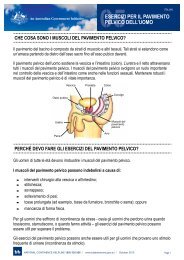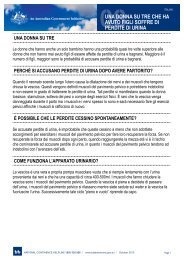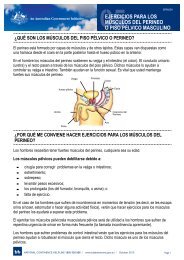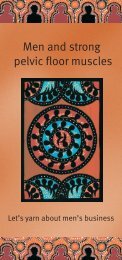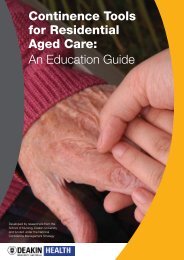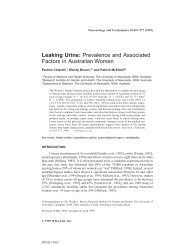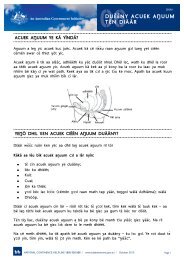Pharmacy Continence Care - Bladder and Bowel Website
Pharmacy Continence Care - Bladder and Bowel Website
Pharmacy Continence Care - Bladder and Bowel Website
Create successful ePaper yourself
Turn your PDF publications into a flip-book with our unique Google optimized e-Paper software.
3 IMPLEMENTATION OF THE PILOT PROGRAM<br />
Implementation of the Program comprised:<br />
• review of Stage 1 training materials <strong>and</strong> development of a training program <strong>and</strong><br />
materials for implementation<br />
• stakeholder consultations to inform the development of the project components<br />
• recruitment of 50 pharmacies from across four states <strong>and</strong> territories, including rural <strong>and</strong><br />
remote pharmacies <strong>and</strong> pharmacies in areas of high migrant populations<br />
• implementation of the training program with the participating pharmacies<br />
• evaluation of the training program outcomes <strong>and</strong> effectiveness through telephone <strong>and</strong><br />
self-administered questionnaire<br />
• a three-month intervention period consisting of:<br />
o pharmacy promotion of continence information <strong>and</strong> assistance to consumers<br />
o recruitment of a number of consumers (target of 10) by each pharmacy to the<br />
outcome <strong>and</strong> effectiveness survey<br />
o completion in-pharmacy by recruited consumers of baseline continence health survey<br />
<strong>and</strong> return of completed surveys by the pharmacies (supported by incentive<br />
payments to pharmacies)<br />
o follow-up outcomes CATI (computer-assisted telephone interview) of r<strong>and</strong>omised<br />
sample of participating consumers <strong>and</strong> follow-up exit interview by telephone with all<br />
participating pharmacies.<br />
3.1 Training Materials<br />
The review of Stage 1 training materials <strong>and</strong> other training materials suitable for application<br />
to this project included:<br />
• the existing training package developed for the <strong>Pharmacy</strong> Guild by the <strong>Continence</strong><br />
Advisory Services of WA, which consisted of:<br />
o training modules for pharmacists<br />
o training modules for pharmacy assistants<br />
• the text <strong>and</strong> CD, Treating Urinary Incontinence in the Community, developed by Assoc.<br />
Professor Richard Millard for general practitioners, which in 2004 was distributed to all<br />
GPs in Australia through the Department of Health <strong>and</strong> Ageing National <strong>Continence</strong><br />
Management Strategy. The Expert Panel considered its application <strong>and</strong> adaptation for<br />
pharmacists <strong>and</strong> pharmacy assistants<br />
• a substantial range of other continence materials, used in education <strong>and</strong> training<br />
undertaken through the National <strong>Continence</strong> Management Strategy or identified through<br />
the literature review, including other relevant materials developed by DoHA, the<br />
<strong>Pharmacy</strong> Society, <strong>and</strong> others including those funded by pharmaceutical companies<br />
• extensive adaptation of available materials, <strong>and</strong> further review of the penultimate draft of<br />
the training materials by the medical <strong>and</strong> pharmacy professionals on the Expert Panel<br />
<strong>and</strong> the <strong>Pharmacy</strong> Guild training manager, prior to submission to the <strong>Pharmacy</strong> Guild<br />
Expert Advisory Group in February 2005. These materials are at Appendix 1.4.<br />
Final Report<br />
12<br />
NOVA Public Policy<br />
<strong>Pharmacy</strong> <strong>Continence</strong> <strong>Care</strong> Project



